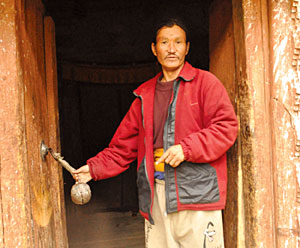 PICS: GORAKH BISTA |
'I could kick him,' rages the ponytailed caretaker monk of Tumkot Monastery (right), referring to a government official who earmarked a paltry Rs 1,500 for renovations recently. 'The government set aside Rs 300,000 three years ago, but only Rs 35,000 made it to our trust fund. They ate it all.'
Chandra Bahadur Lama (below)Âï��is a bitter man. His monastery, a 10-minute walk from the dank, dark village of Tumkot in Muchu VDC, Humla district, is in as dilapidated a state as a living sacred site can be. Some claim it is a 13th century building, and it shows from the moment you step into the confines of its small courtyard. Weeds festoon the broken flagstones, and the rooms surrounding the courtyard, meant to house the representatives of seven villages during festivals, are not even fit for animals. The cave-like prayer room is exposed to the elements (light and rain stream through an open 'skylight') and the murals are caked with mud and grime.
 Chandra Bahadur Lama |
It's understandable, though. For Humla, Tumkot Monastery is arguably more culturally and historically significant than massive Yalbang Monastery, a day's walk down the River Karnali. But it has been largely ignored by devotees and tourists. Chandra Bahadur Lama himself led efforts to raise funds from the villages meant to patronise the monastery, and managed between Rs 200,000-300,000. Subsequent repairs to the roof, however, were not wholly successful. "Now it leaks more than ever before," the monk complains.
As we head back to our campsite, 20 minutes down the mountain, our guide commiserates with Chandra Bahadur Lama. 'Even up to the time of his father, a renowned (and even more ferocious) monk, this monastery was doing fine. But hardly anyone visits now, and even if they did, there's no guarantee it will be open." We pass a German contingent sharing the campgrounds. I recognise a few faces from Yalbang Monastery the day before. There, they sat crosslegged on the floor, expressions devout, for the evening puja. But they are oblivious to what Tumkot has to offer, despite the sign pointing to the monastery off the trail. Perhaps because their guides haven't bookmarked it for a visit.
 GORAKH BISTA |
Meeting the Rinpoche, you can see why Yalbang Monastery is doing so well. He receives us in a spotless, pine-scented room in a small, separate house to the rear of the monastery. He is calm but full of a focused energy, and is approachable yet inspires a natural respect in those who encounter him. He is equally at home lamenting the 'grasping materialism' that bedevils our happiness as he is picking our brains about national politics, and discussing the prospect of a documentary about life in the monastery.
 Rinpoche Pema Riksal |
Today, Yalbang Monastery, with its school and plans for a clinic, stands as a tribute to the dedication of Pema Riksal. Equally, it is a testament to the enduring devotion of the thousands of visitors it receives. The irony lies in the fact that resources are available to construct a new monastery in Humla while a few hillsides away, an ancient monastery is close to ruin. Buddhism itself may remind us of the impermanence of material things. But in our world, the material too often affects the spiritual. As impressed as I was with Yalbang, the only solace I could find in Tumkot was the fact that the monastery remained standing, and in the unlikely form of Chandra Bahadur Lama, had a guardian angel.
READ ALSO:
Food revolution, INDU NEPAL


